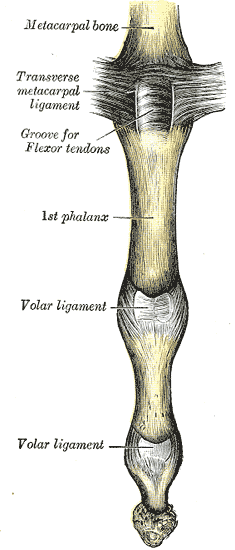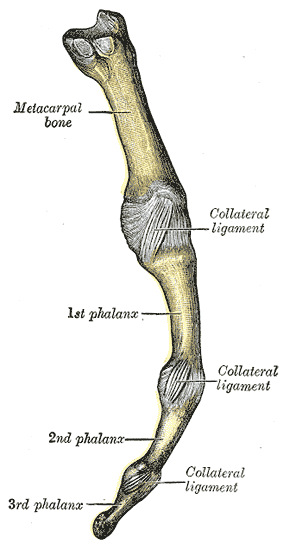Articulations of the Digits

Editor-In-Chief: Prab R Tumpati, MD
Obesity, Sleep & Internal medicine
Founder, WikiMD Wellnesspedia &
W8MD medical weight loss NYC and sleep center NYC
Anatomy > Gray's Anatomy of the Human Body > III. Syndesmology > 6k. Articulations of the Digits
Henry Gray (1821–1865). Anatomy of the Human Body. 1918.
Articulations of the Digits of the Hand[edit]
(Articulationes Digitorum Manus; Interphalangeal Joints)
The articulations of the fingers—specifically the interphalangeal joints—are a series of hinge joints that permit flexion and extension between the phalanges of the hand.


There are two interphalangeal joints in each finger:
- The proximal interphalangeal joint (PIP) – between the proximal and middle phalanges.
- The distal interphalangeal joint (DIP) – between the middle and distal phalanges.
The thumb, having only two phalanges, possesses a single interphalangeal joint.
Ligaments of the Interphalangeal Joints[edit]
Each interphalangeal joint is stabilized by three primary ligaments:
- Palmar ligament (volar plate): A thick, fibrocartilaginous band that reinforces the anterior side of the joint capsule and limits hyperextension.
- Collateral ligaments: Paired medial and lateral bands that provide lateral stability and help guide motion during flexion and extension.
- The extensor tendons serve the function of posterior ligaments, as the joints lack distinct posterior reinforcement.
Movements[edit]
The interphalangeal joints permit the following:
- Flexion: Bending the finger toward the palm.
- Extension: Straightening the finger from a flexed position.
Flexion is more pronounced at the proximal interphalangeal joint (PIP) than at the distal interphalangeal joint (DIP). Extension is restricted by the volar and collateral ligaments.
Muscles Acting on the Joints of the Digits[edit]
Metacarpophalangeal Joints (MCP)[edit]
- Flexion:
Flexor digitorum superficialis Flexor digitorum profundus Lumbricals Palmar interossei and dorsal interossei Flexor digiti minimi brevis (for little finger)
- Extension:
Extensor digitorum Extensor indicis Extensor digiti minimi
Interphalangeal Joints[edit]
- Flexion:
Flexor digitorum superficialis (acts on PIP) Flexor digitorum profundus (acts on PIP and DIP)
- Extension:
Lumbricals and interossei muscles (via their insertion into the extensor expansion) Extensor digitorum plays a limited role directly
Thumb Joints[edit]
- Flexion of MCP joint:
Flexor pollicis brevis Flexor pollicis longus
- Extension of MCP joint:
- Flexion of interphalangeal joint:
- Extension of interphalangeal joint:
Functional Importance[edit]
The interphalangeal and metacarpophalangeal joints are essential for precise hand movements, grasping, and manual dexterity. These joints are stabilized by a complex interplay of passive (ligaments) and dynamic (muscular) support systems. Disruption of any of these structures can result in impaired function, such as in cases of arthritis, tendon injury, or joint instability.
See Also[edit]
- Phalanges
- Hand
- Extensor mechanism of the hand
- Flexor tendons of the hand
- Interphalangeal joints of the foot
| Joints and ligaments of the arm | ||||||||
|---|---|---|---|---|---|---|---|---|
|
Gray's Anatomy[edit]
- Gray's Anatomy Contents
- Gray's Anatomy Subject Index
- About Classic Gray's Anatomy
- Glossary of anatomy terms
Anatomy atlases (external)[edit]
[1] - Anatomy Atlases
| Human systems and organs | ||||||||||||||
|---|---|---|---|---|---|---|---|---|---|---|---|---|---|---|
|
Adapted from the Classic Grays Anatomy of the Human Body 1918 edition (public domain)
Ad. Transform your life with W8MD's Budget GLP-1 injections from $75


W8MD offers a medical weight loss program to lose weight in Philadelphia. Our physician-supervised medical weight loss provides:
- Weight loss injections in NYC (generic and brand names):
- Zepbound / Mounjaro, Wegovy / Ozempic, Saxenda
- Most insurances accepted or discounted self-pay rates. We will obtain insurance prior authorizations if needed.
- Generic GLP1 weight loss injections from $75 for the starting dose.
- Also offer prescription weight loss medications including Phentermine, Qsymia, Diethylpropion, Contrave etc.
NYC weight loss doctor appointmentsNYC weight loss doctor appointments
Start your NYC weight loss journey today at our NYC medical weight loss and Philadelphia medical weight loss clinics.
- Call 718-946-5500 to lose weight in NYC or for medical weight loss in Philadelphia 215-676-2334.
- Tags:NYC medical weight loss, Philadelphia lose weight Zepbound NYC, Budget GLP1 weight loss injections, Wegovy Philadelphia, Wegovy NYC, Philadelphia medical weight loss, Brookly weight loss and Wegovy NYC
|
WikiMD's Wellness Encyclopedia |
| Let Food Be Thy Medicine Medicine Thy Food - Hippocrates |
Medical Disclaimer: WikiMD is not a substitute for professional medical advice. The information on WikiMD is provided as an information resource only, may be incorrect, outdated or misleading, and is not to be used or relied on for any diagnostic or treatment purposes. Please consult your health care provider before making any healthcare decisions or for guidance about a specific medical condition. WikiMD expressly disclaims responsibility, and shall have no liability, for any damages, loss, injury, or liability whatsoever suffered as a result of your reliance on the information contained in this site. By visiting this site you agree to the foregoing terms and conditions, which may from time to time be changed or supplemented by WikiMD. If you do not agree to the foregoing terms and conditions, you should not enter or use this site. See full disclaimer.
Credits:Most images are courtesy of Wikimedia commons, and templates, categories Wikipedia, licensed under CC BY SA or similar.
Translate this page: - East Asian
中文,
日本,
한국어,
South Asian
हिन्दी,
தமிழ்,
తెలుగు,
Urdu,
ಕನ್ನಡ,
Southeast Asian
Indonesian,
Vietnamese,
Thai,
မြန်မာဘာသာ,
বাংলা
European
español,
Deutsch,
français,
Greek,
português do Brasil,
polski,
română,
русский,
Nederlands,
norsk,
svenska,
suomi,
Italian
Middle Eastern & African
عربى,
Turkish,
Persian,
Hebrew,
Afrikaans,
isiZulu,
Kiswahili,
Other
Bulgarian,
Hungarian,
Czech,
Swedish,
മലയാളം,
मराठी,
ਪੰਜਾਬੀ,
ગુજરાતી,
Portuguese,
Ukrainian